With ever more Internet of Things (IoT) devices and changing architectures and data management approaches to turn ever more data from this growing number of IoT devices into actionable intelligence, the importance of IoT device management can hardly be underestimated.
An overview of IoT device management platforms (DMPs), device management in IoT platforms and Industrial IoT platforms, other IoT device management approaches and the IoT device management market in an evolving IoT platform market.
On top of the challenges concerning the management of ever more IoT devices, key challenges with regards to IoT device management include IoT security, which obviously plays on the IoT device level (that includes IoT gateways in the scope of this article) too and, among others, means quick (over-the-air) patching, firmware updating and IoT device visibility in networks; speed of processing and analyzing data to feed essential business applications in real-time (with edge computing and fog computing, the role of artificial intelligence and hardware-agnostic capabilities) and the time it still takes to onboard new IoT devices and you have some of the issues surrounding IoT device management.
Obviously, interoperability in an ocean of standards and protocols, network and communication methods and so forth, is another key topic, as is scalability in ever larger IoT projects with more IoT assets and devices, certainly in the industrial IoT verticals of Industry 4.0.
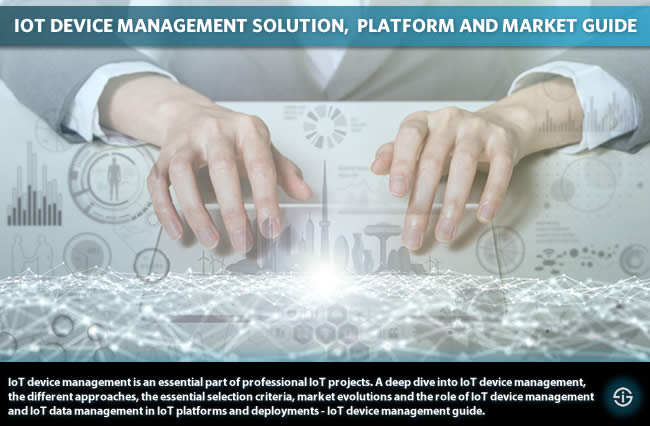
IoT device management gets handled in several ways, yet in the end only end-to-end device management and IoT device lifecycle management respond to end-to-end solution needs from customers and the essential security challenges which are tackled with device management.
The many roads to IoT device management – and why it matters
In more than one sense there are overlaps between IoT device management and mobile device management or MDM (think automatic detection, patching and over-the-air updates, management and programming).
The same goes for network device management (which is the approach that some vendors take with their solutions) and device management in the scope of network connectivity providers and broadband operators (with, among others, Gemalto Device Management that automatically detects and configures all mobile devices for mobile network operators, a solution from security expert Gemalto which is co-founder of the blockchain consortium known as TIoTA that works toward a common IoT registration protocol, among others aiming to change the approaches that underpin today’s IoT device identities) and so on.
And then there are of course traditional M2M IoT device management solutions, IoT device management platforms for more consumer-oriented markets, the Arm Mbed IoT Device Platform ecosystem approach and more (with the first blockchain IoT device management applications and initiatives here too).
In the context of this article we mainly look at IoT device management as an inherent part of real IoT platforms and Industrial IoT platforms and at IoT Device Management Platforms, a.k.a. DMPs. Here as well there are overlaps since IoT platforms of device and network connectivity providers such as Vodafone and Sierra Wireless, to name a few, offer IoT device management too (more about that below).
IoT device management is a key capability with several functions of IoT platforms. Previously we mentioned the MachNation MIT-E IoT platform test data environment (MachNation is known from its annual MachNation IoT platform ScoreCard and in 2018 also published its first MachNation IoT Edge ScoreCard).
As you can see in the image from the MIT-E report which MachNation provides as a result of its analysis and tests to buyers in the market for IoT platforms, device management is one of the cornerstones of its IoT platform test categories.
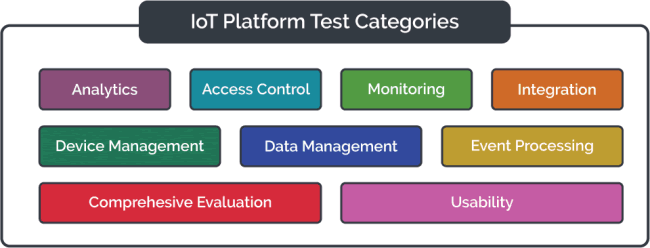
According to Nicolas Windpassinger, author of the book Digitize or Die, IoT platforms deliver the following basic M2M services: connectivity support, service enablement, device Management, application support and solution provider.
Horizontal IoT apps such as device management apps are too often incorrectly labeled “platforms” he emphasizes. IoT platforms have specific IoT capabilities on top of these M2M services and horizontal IoT apps, such as application development, application management and scalability.
IoT device management – several key functions that are essential for successful IoT projects at scale
On the mentioned landing page of the MIT-E report you can also download an example of a report for one IoT platform, Amazon AWS IoT, that further drills down into the various elements that are tested on this device management level.
In total there are 25 of such device management test areas which are segmented into following ‘groups’: device deployment, device connectivity, device definitions/group, monitoring, edge monitoring, edge management, firmware/software management, remote configuration/actions, sunsetting and diagnostics/troubleshooting.
Along with bulk device management these come back in the March 2018 announcement of MachNation’s report focused on IoT platform device management which contains hands-on device management test results from 11 IoT platform vendors as the announcement states: Altizon, Amazon, Bosch, GE, Google, IBM, Litmus Automation, Microsoft, Sierra Wireless, Software AG and Thingsboard.
MachNation defines device management as the ability of a platform to provide lifecycle management functionality for connected devices, including device onboarding, deployment of software and firmware updates, and configuration of managed devices.
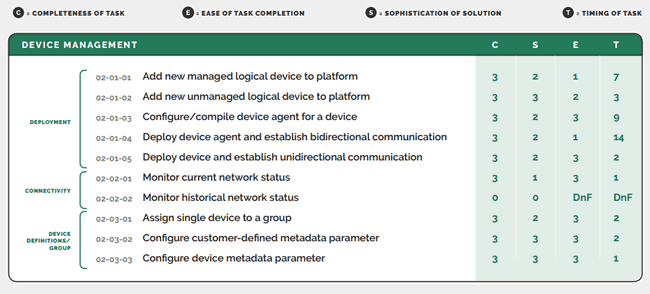
IoT device management platforms (DMPs)
When gauging the IoT device management market in the Summer of 2017 in the industry’s first “State of the IoT Device Management Platform (DMP) Market Report”, MachNation described such IoT device management platforms as an offering that provides device lifecycle management functionality associated with the deployment and management of IoT assets and summed up some of these typical IoT assets: IoT gateways, retrofitted and new industrial equipment and Linux-based Arduino-like devices.
Among the typical functions of DMPs are asset provisioning, firmware upgrades, security patching, alerting and reporting on specific metrics associated with IoT assets, MachNation added, further emphasizing that the IoT DMP space is not well understood.
Earlier in 2017, MachNation rated IoT Device Management vendors in a ScoreCard whereby the company’s Sam Hale pointed out that the IoT device management space is quite complex and until now has been less deeply understood than other technology sectors in IoT.
Tested DMP vendors/solutions included ARM, Amazon, Axonize, Bosch, Cloud of Things, Cumulocity (Software AG), DevicePilot, Friendly Technologies, Huawei, Microsoft, Particle, PTC, Proximetry (acquired in 2017 by relayr), Sierra Wireless, SiteWhere, Telit, Thingsboard and Wind River (Intel).
Again, we need to emphasize that on top of these device management platform vendors, there are the IoT platform vendors and solutions which need to have device management within their features (and that includes several of the already mentioned ones).
If you’re looking for companies which have IoT platforms providing cellular connectivity management and/or other capabilities such as device management, IDC looked at that IoT platform segment which we mentioned earlier, evaluating AT&T, Cisco, Ericsson, Huawei, Orange Business Services, Particle, Sierra Wireless, Telefonica, Telit, Verizon and Vodafone.
Attention: the analysis from IDC and of many others that watch the IoT platform and IoT device management platform market, as far as we know, is not based upon tests.
IoT device management in IoT platforms – how to choose?
What would you want to keep into account when looking at IoT device management solutions and when looking at the IoT device management possibilities of IoT platforms?
On top of some classic IoT platform considerations from a business perspective (starting from your goals, use cases and IoT device priorities within your particular context of IoT deployments with data streams and analysis as the key in powering applications; taking into account the roadmap of the vendor and your own future IoT plans; checking if the partnerships and ecosystems of the vendor match your needs; making sure there is support for evolutions that matter to you such as machine learning and/or edge and fog and/or IoT assets that matter to you in a potentially advanced way with evolutions such as digital twins and augmented reality; seeing if there is a focus on end-to-end device lifecycle management and end-to-end solutions with clear value; checking the open nature of the platform and interoperability for the present and future, thereby avoiding lock-in; considering whether you need a more vertical platform, a more generic one, a mix of several solutions and so forth) below are some essential ‘more technical’ elements to look at.
IoT device/asset onboarding, enrollment, provisioning and deployment
When Intel announced the beforementioned zero-touch IoT device onboarding SDO platform it reminded the essential challenge of device provisioning (and device management), emphasizing that adding a device can take over 20 minutes per device, among others because several teams need to work together.
Obviously, Intel is not alone. IoT device management solutions such as Intel’s own Wind River (which is integrated with Intel SDO), Telit and Greenwave Systems, to name a few, allow for zero-touch onboarding with provisioning, authentication and data encryption. This whole process of onboarding, provisioning, authentication, deployment and encryption essentially is about secure and rapid deployment (at scale) whereby security and trust are key. Authentication means giving an identity to the IoT device/asset and adding it as a trusted identity whereby device provisioning attaches a certificate to the identity although approaches and definitions can vary. In this process there is also an initial configuration and a first monitoring.
IoT device/asset configuration, control, management and maintenance
When a device/asset gets onboarded, configuration starts as does device monitoring, primarily in the scope of device status.
However, obviously configuration and control need to be further finetuned beyond the default settings in function of your IoT project and needs. Moreover, you want to check for potential firmware updates, intervene if there are device status issues and check/change configuration settings while enabling the control possibilities you need for device maintenance and device management. It’s here that, among others, over-the-air possibilities become important, for instance for the settings, monitoring and diagnostics. The latter is also important for security reasons as diagnostics can point to security issues.
IoT device/asset management software updates and firmware updates
In a January 2018 whitepaper on selecting best-in-class platforms for IoT device and data management, MachNation emphasizes the differences between IoT data management and device management platforms and features, stating that IoT device management platforms extend the capabilities of IoT data-focused platforms by providing rock-solid device management services with edge-to-cloud security built-in.
For MachNaton IoT device management platforms have three essential capabilities: 1) ‘deployment and monitoring’, 2) ‘maintenance and management’ and 3) ‘software and firmware updates’ as the picture below shows. It’s close to the same as the mentioned ones whereby here we’re in the latter area. On top of managing IoT devices and assets from a troubleshooting, device status and health and diagnostics perspective (which, again, already touch upon the security aspect with replication of issues and corrective measures) the ability to publish security updates quickly and efficiently helps ensure that vulnerabilities are mitigated before they can be exploited by bad actors, making this capability a critical element of an enterprise’s security posture MachNation states as you can read in the whitepaper which you can download here.
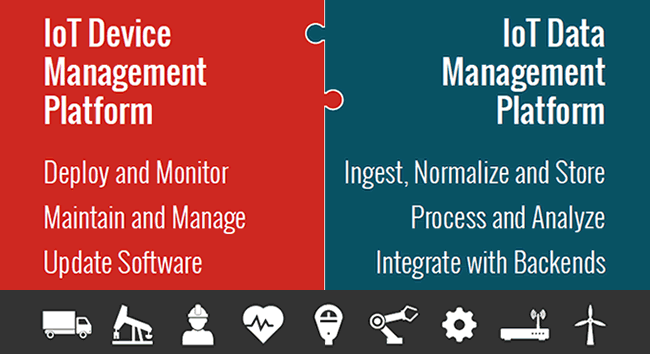
Other considerations regarding IoT device management capabilities
On top of the mentioned key areas, there are more overall IoT device management and control functions. Security for us is a key element in it all, on top of the need for speed and scale in IoT projects with ever more devices, connected assets and data. Scalability is also important as such of course, especially in larger projects.
Add to that the potential need to manage devices within IoT platforms that are tailored for your vertical industry, types of assets and use cases and you already have quite some considerations regarding IoT device management and the choices to make in a scope of DMPs and IoT platforms.
MachNation further emphasizes that enterprises need both IoT data management and IoT device management to support the end-to-end design, testing, launch and operation of an IoT solution.
From a security perspective we can further point to the risks of IoT deployments and importance of security in IoT device management and IoT platforms in areas where this is mission-critical. One can indeed think about Industry 4.0, utilities and resources industries, critical infrastructure (with some well-known examples of state-sponsored attacks), critical power building environments (hospitals, airports and so forth) and more. However, security plays a role on all levels.
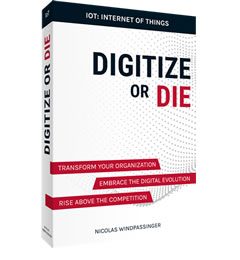
It’s as Nicolas Windpassinger says in his mentioned IoT book Digitize or Die when tackling the IoT stack which he sees as consisting of four horizontal levels: devices, IoT gateways, IoT platforms and the business applications. It’s clear that device management plays and security play on all levels (with IoT gateways included in IoT device management). Nicolas also defines two transversal layers: security and communications. It’s clear that here as well security needs to be present in connectivity and that connectivity is important in IoT device management (standards, protocols, the mentioned device management platforms in the scope of network connectivity providers and broadband operators, etc.)
And choosing the best solution from this security viewpoint does matter. In its March 2018 IoT security spending forecasts 2018-2021, Gartner pointed out that the selection of IoT device vendors, IoT gateways, IoT services and so forth is still largely ad hoc and based upon the partnerships and ecosystems of device providers. It’s clear that IoT device management plays a key role in its global IoT security spending forecasts which are depicted below.
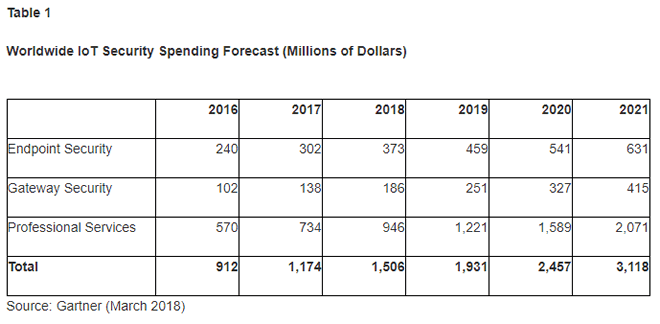
The IoT device management market in evolution: forecasts and drivers
We end with an overview of the IoT device management market from a spending perspective. In the previously cited 2017 “State of the IoT Device Management Platform (DMP) Market Report”, MachNation forecasted that the IoT device management market (meaning the ‘real’ DMP market) would grow with 107 percent over the next 12 months.
Earlier in 2017 a Mind Commerce report stated that IoT device management would be one of the fastest growing areas for solution providers with a substantial market opportunity for PaaS and SaaS based IoT device management, expected to reach $3.1B by 2022 with North America leading the IoT device management platform market ($958M by 2022) as you can read here.
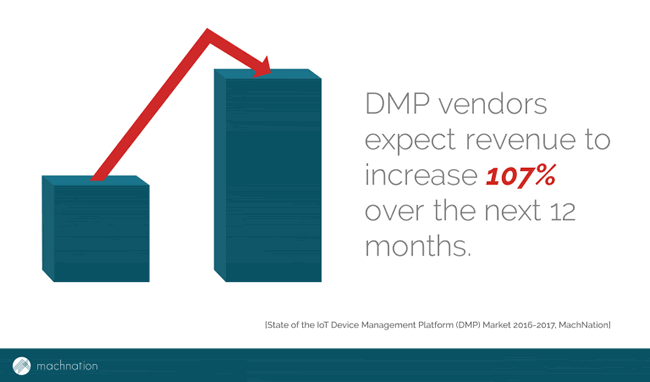
Early January 2018 Mind Commerce published what it called an “IoT Things Management Market” update (whereby IoT device management and IoT data management are included), forecasting a PaaS IoT Things Management revenue of $11B by 2023.
More recently, in March 2018, Grand View Research sent out various press releases regarding its global IoT device management market forecast. According to that research, the global IoT device management market would reach $5.1B by 2025 (or a 28.3% CAGR during the forecast period).
The company splits the IoT device management market up in several solutions as you can see below. These also include data management, to name one example, which is important to take into account when comparing with what MachNation sees as the functions of IoT device management as previously depicted. Also network bandwidth management and real-time streaming analytics are included on top of security and remote IoT device/asset monitoring.
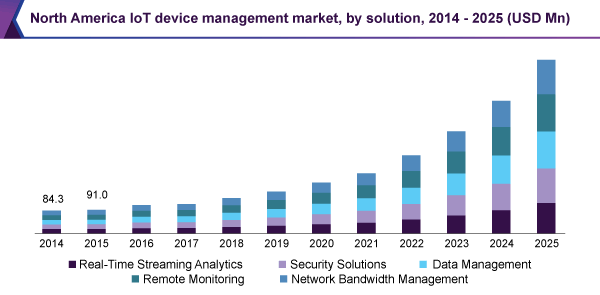
Obviously, one can’t compare one forecast with another but it’s clear that security is and will be a strong driver of the market. According to Grand View Research, security solutions is expected to be the fastest-growing segment in the IoT device management market with a CAGR of 29.2% over the forecast period. Also, operational efficiencies are mentioned as market drivers. Grand View further points out the role of initiatives, such as the Open Mobile Alliance (OMA), for standardizing protocols.
Grand View looks at, among others, following vendors/platforms: IBM, Aeris Communications, Microsoft, Bosch Software Innovations, Oracle, PTC and Advantech.
Regardless of the precise numbers and all the forecasts and, considering the fact that different analysts do have different approaches and views, the essence remains: make sure you pick the right approach to IoT device management and right IoT platform with IoT device management if that is your approach, that meets both the mentioned business aspects and technology/performance aspects within your company’s business context.
Moreover, do remember that while IoT device management is key it is one of many aspects of an IoT platform to consider and more evolutions are shaping what you might need as previously mentioned in our IoT platform market evolutions overview.
Top image: Shutterstock – Copyright: chombosan – All other images are the property of their respective mentioned owners






